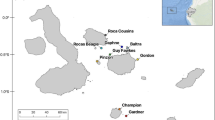Abstract
Animals use sensory stimuli either to assess and select habitats, mates or food, as well as for communication. The present study aimed to understand the behavioural processes enabling several Chaetodon species (butterflyfishes) to locate one of their food sources (epibionts present on pearl oyster shells) at Rangiroa atoll (French Polynesia). Among the five species tested, our 2-channel choice flume chamber experiments identified three species that were attracted to their food source by chemical stimuli. HPLC experiments showed that pearl oysters and epibionts have specific and unique chemical fingerprints, either one or nine specific peaks, respectively. Overall, chemical stimuli are emitted by both epibionts (used directly by Chaetodon auriga, C. lunula and C. citrinellus) and live pearl oysters (used indirectly by C. auriga and C. lunula) to locate their food source. Biosynthesis of these chemical stimuli could be used to artificially attract butterflyfishes to pearl oyster rearing stations in order to increase the natural cleaning of pearl oyster shells and thus reduce one large cost for this aquaculture.



Similar content being viewed by others
References
Barata EN, Hubert F, Conceição LEC, Velez Z, Rema P, Hubbard PC, Canário AVN (2009) Prey odour enhances swimming activity and feed intake in the Senegalese sole. Aquaculture 293:100–107
Cassier P, Bohatier J, Descoins C, Le Meillour P (2000) Communication chimique et environnement. Belin, Paris
Che LM, Alsumard T, Boury-Esnault N, Payri C, Golubic S, Bezac C (1996) Biodegradation of shells of the black pearl oyster, Pinctada margaritifera, by microborers and sponges of French Polynesia. Mar Biol 126:509–519
Constantino MA, Salmon M (2003) Role of chemical and visual cues in food recognition by leatherback posthatchlings (Dermochelys coriacea). Zoology 106:173–181
De Nys R, Ison O (2008) Biofouling. In: Southgate PC, Lucas JS (eds) The pearl oyster, 1st edn. Elsevier, Oxford, pp 527–553
Derby CD, Sorensen PW (2008) Neural processing, perception, and behavioral responses to natural chemical stimuli by fish and crustaceans. J Chem Ecol 34:898–914
Gerlach G, Atema J, Kingsford MJ, Black KP, Miller-Sims V (2007) Smelling home can prevent dispersal of reef fish larvae. Proc Natl Acad Sci 104:858–863
Hara TJ (2006) Feeding behaviour in some teleosts is triggered by single amino acids primarily through olfaction. J Fish Biol 68:810–825
Kendal RL, Kendal JR, Hoppitt W, Laland KN (2009) Identifying social learning in animal populations: a new ‘option-bias’ method. PLoS ONE 4:12–19
Lecchini D, Galzin R (2003) Influence of pelagic and benthic, biotic and abiotic, stochastic and deterministic processes on the dynamics of auto-recruitment of coral reef fish. Cybium 27:167–184
Lecchini D, Osenberg CWO, Shima JS, StMary C, Galzin R (2007) Ontogenetic changes in habitat selection during settlement in a coral reef fish: ecological determinants and sensory mechanisms. Coral Reefs 26:423–432
Lecchini D, Mills SC, Brié C, Maurin R, Banaigs B (2010) Ecological determinants and sensory mechanisms in habitat selection of crustacean larvae. Behav Ecol 21:599–607
Mant CT, Hodges RS (1991) High-performance liquid chromatography of peptides and proteins: separations, analysis, and conformation. CRC, Boston
Pit JH, Southgate PC (2003) Fouling and predation; how do they affect growth and survival of the blacklip pearl oyster, Pinctada margaritifera, during nursery culture? Aquacult Int 11:545–555
Reader SM, Kendal JR, Laland KN (2003) Social learning of foraging sites and escape routes in wild Trinidadian guppies. Ani Behav 66:729–739
Southgate PC, Lucas JS (2008) The pearl oyster. Elsevier, Oxford
Acknowledgements
Centre IRD Tahiti and Noumea (J. Iltis, P. Dumas, D. Ponton), Tropical Fish Tahiti (A. Lerebours), CRIOBE (R. Galzin, S. Planes), Service de la Perliculture (M. Bellais) and Service de la Pêche (G. Remoissenet) of French Polynesia for kindly agreeing to house this study in their facilities. This research was supported by grants from ANR (ANR-06-JCJC-0012-01), MOM (06 PF 15) and CRISP program (Coral Reef Initiatives in the South Pacific—C2A1).
Author information
Authors and Affiliations
Corresponding author
Rights and permissions
About this article
Cite this article
Lecchini, D., Mills, S.C., Brié, C. et al. Chemical stimuli in coral reefs: how butterflyfishes find their food. Environ Biol Fish 91, 303–309 (2011). https://doi.org/10.1007/s10641-011-9785-3
Received:
Accepted:
Published:
Issue Date:
DOI: https://doi.org/10.1007/s10641-011-9785-3




